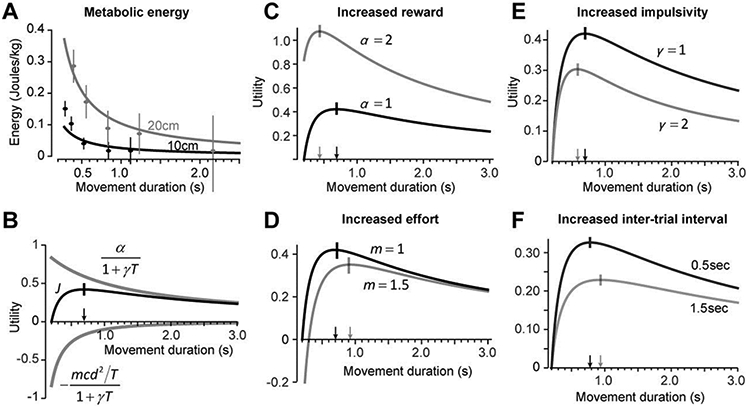Figure 1.

The effects of reward, effort, and time on decision-making and movement vigor. A. Metabolic energy expended during reaching as a function of reach duration for different distances. The data were fit to Eq. (5) to provide an estimate of parameter c. Error bars are SEM. B. The gray curves are the temporally discounted reward and metabolic cost of the movement, plotted as a function of movement duration, for a constant amplitude movement (Eq. 7). The black curve is the utility, which is the sum of the temporally discounted reward and metabolic cost. Increased movement duration T reduces both reward and effort, but has a greater effect on effort. As a consequence, the utility has a peak, corresponding to the duration of movement that maximizes the discounted sum of reward and effort. The small vertical line and the arrow indicate the movement duration that maximizes the utility. C. With increased reward, the utility of the movement increases for all durations. In addition, the optimal duration shifts to a smaller value. As a result, a stimulus that promises greater reward not only carries a greater utility, but also produces movements that have greater velocity (reduced duration). D. The effort of the movement is increased by increasing the mass of the limb. This decreases the utility of the movement for all durations, but also shifts the optimal duration to a larger value, thereby decreasing the velocity of the resulting movement. E. The effect of increased rate of temporal discounting. Increasing the rate of temporal discounting decreases the utility of the movement for all durations, but also shifts the optimal duration to a smaller value, thereby increasing movement velocity. F. The effect of increased inter-trial interval. Increased inter-trial interval decreases the utility of the movement for all durations, but shifts the optimal duration to a larger value, thereby decreasing movement velocity. Therefore, while increased inter-trial interval and rate of temporal discounting both decrease utility of the movement, the former decreases movement vigor, while the later increases it.
